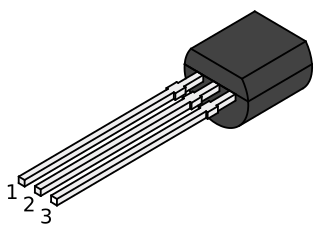
A transistor is a semiconductor device used to amplify or switch electronic signals and electrical power. It is composed of semiconductor material usually with at least three terminals for connection to an external circuit. A voltage or current applied to one pair of the transistor's terminals controls the current through another pair of terminals. Because the controlled (output) power can be higher than the controlling (input) power, a transistor can amplify a signal. Today, some transistors are packaged individually, but many more are found embedded in integrated circuits.

In digital logic, an inverter or NOT gate is a logic gate which implements logical negation. The truth table is shown on the right.

In electronics, a common-emitter amplifier is one of three basic single-stage bipolar-junction-transistor (BJT) amplifier topologies, typically used as the voltage amplifier.
Bipolar CMOS (BiCMOS) is a semiconductor technology that integrates two formerly separate semiconductor technologies, those of the bipolar junction transistor and the CMOS gate, in a single integrated circuit device.
The heterojunction bipolar transistor (HBT) is a type of bipolar junction transistor (BJT) which uses differing semiconductor materials for the emitter and base regions, creating a heterojunction. The HBT improves on the BJT in that it can handle signals of very high frequencies, up to several hundred GHz. It is commonly used in modern ultrafast circuits, mostly radio-frequency (RF) systems, and in applications requiring a high power efficiency, such as RF power amplifiers in cellular phones. The idea of employing a heterojunction is as old as the conventional BJT, dating back to a patent from 1951. Detailed theory of heterojunction bipolar transistor was developed by Herbert Kroemer in 1957.
The cascode is a two-stage amplifier that consists of a common-emitter stage feeding into a common-base stage.

The TO-92 is a widely used style of semiconductor package mainly used for transistors. The case is often made of epoxy or plastic, and offers compact size at a very low cost.

An electronic symbol is a pictogram used to represent various electrical and electronic devices or functions, such as wires, batteries, resistors, and transistors, in a schematic diagram of an electrical or electronic circuit. These symbols are largely standardized internationally today, but may vary from country to country, or engineering discipline, based on traditional conventions.

The point-contact transistor was the first type of transistor to be successfully demonstrated. It was developed by research scientists John Bardeen and Walter Brattain at Bell Laboratories in December 1947. They worked in a group led by physicist William Shockley. The group had been working together on experiments and theories of electric field effects in solid state materials, with the aim of replacing vacuum tubes with a smaller device that consumed less power.
An extrinsic semiconductor is one that has been doped; during manufacture of the semiconductor crystal a trace element or chemical called a doping agent has been incorporated chemically into the crystal, for the purpose of giving it different electrical properties than the pure semiconductor crystal, which is called an intrinsic semiconductor. In an extrinsic semiconductor it is these foreign dopant atoms in the crystal lattice that mainly provide the charge carriers which carry electric current through the crystal. The doping agents used are of two types, resulting in two types of extrinsic semiconductor. An electron donor dopant is an atom which, when incorporated in the crystal, releases a mobile conduction electron into the crystal lattice. An extrinsic semiconductor which has been doped with electron donor atoms is called an n-type semiconductor, because the majority of charge carriers in the crystal are negative electrons. An electron acceptor dopant is an atom which accepts an electron from the lattice, creating a vacancy where an electron should be called a hole which can move through the crystal like a positively charged particle. An extrinsic semiconductor which has been doped with electron acceptor atoms is called a p-type semiconductor, because the majority of charge carriers in the crystal are positive holes.
The spacistor was a type of transistor developed in the 1950s as an improvement over the point-contact transistor and the later alloy junction transistor. It offered much higher speed than earlier transistors. It became obsolete in the early 1960s with the development of the diffusion transistor.
A diffused junction transistor is a transistor formed by diffusing dopants into a semiconductor substrate. The diffusion process was developed later than the alloy junction and grown junction processes for making BJTs.
A diode-connected transistor is a method of creating a two-terminal rectifying device out of a three-terminal transistor. A characteristic of diode-connected transistors is that they are always in the saturation region for metal-oxide-semiconductor field-effect transistors (MOSFETs) and junction-gate field-effect transistors (JFETs), and in the active region for bipolar junction transistors (BJTs).

A multiple-emitter transistor is a specialized bipolar transistor mostly used at the inputs of integrated circuit TTL NAND logic gates. Input signals are applied to the emitters. The voltage presented to the following stage is pulled low if any one or more of the base–emitter junctions is forward biased, allowing logical operations to be performed using a single transistor. Multiple-emitter transistors replace the diodes of diode–transistor logic (DTL) to make transistor–transistor logic (TTL), and thereby allow reduction of switching time and power dissipation.
The following outline is provided as an overview of and topical guide to electronics:

The field-effect transistor (FET) is an electronic device which uses an electric field to control the flow of current. FETs are devices with three terminals: source, gate, and drain. FETs control the flow of current by the application of a voltage to the gate, which in turn alters the conductivity between the drain and source.
ADMS is a public domain software to translate Verilog-A models into C-models which can be directly read by a number of SPICE simulators, including Spectre Circuit Simulator, Ngspice and HSpice.
This page is based on this
Wikipedia article Text is available under the
CC BY-SA 4.0 license; additional terms may apply.
Images, videos and audio are available under their respective licenses.








